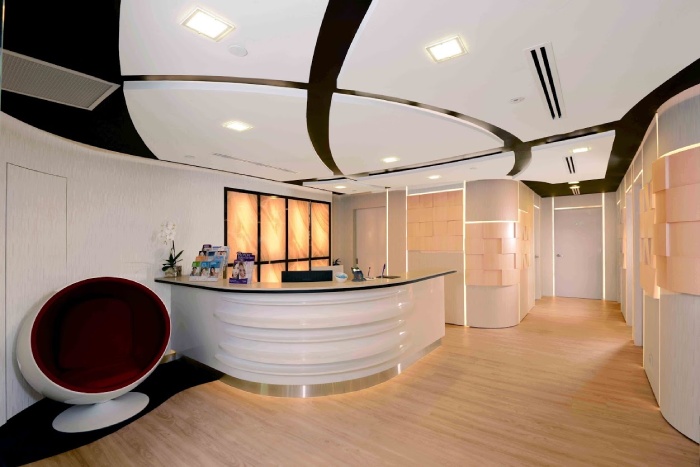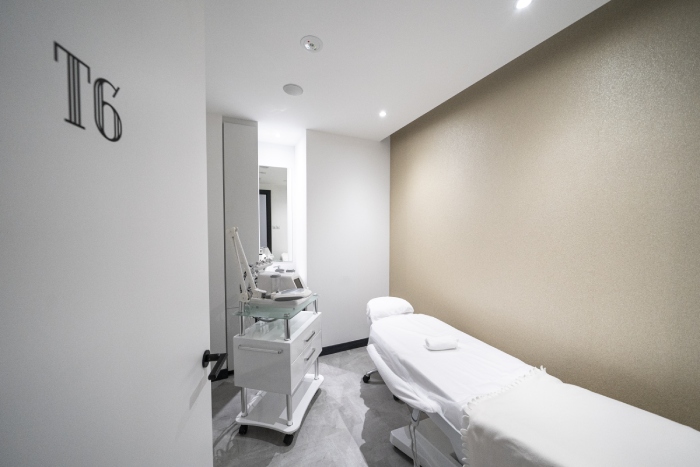Looking for a way to regain a youthful appearance without going under the knife? A thread lift might be the perfect solution for you. This minimally invasive cosmetic procedure is gaining popularity for its ability to subtly lift and tighten sagging skin.
Read on as Daily Vanity shares everything you need to know about the procedure, including where to get it in Singapore.
- What Is a Thread Lift?
- How Does a Thread Lift Work?
- What Are the Different Types of Thread Lifts Available in Singapore?
- Which Parts of the Face Can It Be Performed and How Soon Can Results Be Seen?
- How Much Does It Cost in Singapore?
- Where To Get a Face Thread Lift in Singapore?
- Frequently Asked Questions
What Is a Thread Lift?

Source: depositphotos
Thread lifts have been around since the 1990s. Still, innovations in the material used, as well as a higher interest in trying out less invasive facelift procedures among beauty-seekers, have led to an increase in popularity worldwide in recent years.
Currently, there are three types of materials used in the procedure:
- Polydioxanone (PDO): The first to be used in the world for this procedure, and offers results that last for six to 12 months;
- Poly-L-lactic acid (PLLA): Releases lactic acid to the treatment area and stimulates the production of collagen; and
- Polycaprolactone (PCL): The latest type of material that’s stronger and longer-lasting.
These sutures gently lift and reposition sagging tissues, resulting in a more sculpted and defined jawline, smoother cheeks, and reduced jowls. PDO threads also stimulate collagen production over time, further enhancing the lifting effect.
How Does a Thread Lift Work?

Source: depositphotos
Also called a barbed suture lift, it aims to lift and sculpt the shape of your face using temporary, medical-grade thread material to “pull up” your skin so that it’s drawn taut.
Apart from offering a lifted effect, the procedure also triggers the body’s natural healing response.
This happens because your body detects a foreign suture material and stimulates collagen production in the treatment area even though you’re technically not injured by the threads under your skin.
The collagen can then fill gaps in sagging skin while restoring elasticity and youthfulness to your mien.
What Are the Different Types of Thread Lifts Available in Singapore?
In Singapore, you will come across three types of thread lifts, categorised according to the thread material used.
- Mono threads: Smooth threads without barbs that are inserted in a mesh-like form to cause skin tightening;
- Tornado/screw threads: Shaped like a tornado with two threads intertwined; and
- Cog threads: Mono threads with barbs that hook to the skin to create a lift.
Which Parts of the Face Can It Be Performed and How Soon Can Results Be Seen?

Source: Joeyy Lee/Unsplash
You can consider facial thread lifts for areas that tend to look less tight over time. This includes:
- the cheeks
- forehead
- eyebrows
- under the eye
- nose
- jawline
- neck
Because of how it works, it can sometimes be performed on breasts to address sagginess too, especially after pregnancy and weight loss.
Additionally, the results typically become visible as soon as the treated area heals, which typically occurs within approximately three days. However, it’s important to note that for certain individuals, this process may take a bit longer, and such variations are completely normal.
If you have any uncertainties or questions regarding your procedure, don’t hesitate to communicate with your physician for clarification.
How Much Does It Cost in Singapore?
A procedure in Singapore can cost anywhere between S$1,000 and S$8,000, depending on the brand, type, and the number of threads used as well as your doctor’s experience in performing thread lifts.
Where To Get a Face Thread Lift in Singapore?
ICON Aesthetics
![]()
ICON Aesthetics was founded with the sole goal of helping you achieve the skin and silhouette of your dreams with a suite of aesthetic treatments, including the Iconic Needleless Threadlift.
Considered a painless, non-invasive alternative to achieve a slimmer facial contour without going under the knife, the Iconic Needleless Threadlift is a unique procedure that has won the Best Medispa Non-Invasive Face Lift (Influencers’ Choice) award in the Daily Vanity Spa & Hair Awards 2021.
![]()
How unique? Well, the treatment utilises polydioxanone (PDO) threads from Korea which are first dissolved into the skin using a specially formulated serum that’s specially designed to break the threads into tiny molecules.
![]()
To ensure stable penetration of active ingredients into skin layers, the treatment employs a Transfer Double Nanosphere technology and further enhances the skin lifting and tightening effects with focused ultrasound energy.
The treatment makes a great anti-ageing solution as it works to boost your skin’s natural collagen production while enhancing skin elasticity, so you can expect to see a more visible V-shaped facial contour and younger-looking skin with regular sessions.
The Iconic Needleless Threadlift is priced at S$280 per session but first-time customers can try it at S$198 by signing up here!
Illumia Medical

Illumia Medical is one of the go-to destinations for bespoke medical aesthetic treatments for many Singaporeans.
The team is led by Medical Director, Dr. Ram Nath, who has over 20 years of experience in medical aesthetics with a belief that there is no one-size-fits-all solution when it comes to medical aesthetics.
Hence, why they have a comprehensive, customised treatment plan for every one of their customers. For individuals who’d like to defy the ageing processes without going under the knife, can try the Illumia V-FaceLift.
The Illumia V-FaceLift creates the results of pulling back the skin slightly, thus lifting and tightening the face. It stimulates the body’s natural healing response by generating collagen at the treated area, which further adds to the lifting and plumping effects.
For this treatment, there are three different types of PDO threads:
- PDO mono threads are smooth sutures that help to rejuvenate your skin by stimulating collagen production to support the skin.
- PDO cog threads contain barbs that latch into your skin like hooks to provide support and lift your face.
- PDO screw threads are made up of one or two intertwined threads to help restore volume at sunken areas of the skin
Sozo Aesthetic Clinic

Rediscover the best version of yourself with the transformative Silhouette Soft Thread Lift treatment from Sozo Aesthetic Clinic.
Designed for the busy, modern individuals, Sozo’s treatment can seamlessly fit into your busy lifestyle, boasting quick recovery and minimal downtime.
Silhouette Soft can be used to treat various parts of the face such as contours of the face, jawline, cheeks, and neck.�With just one treatment, it delivers dual benefits:
- A lifting action for immediate and discreet effect.
- Over time this thread lift procedure will stimulate and promote the regeneration of lost collagen to recapture youthful definition and restore volume.
The Clifford Clinic

For those seeking to rejuvenate their facial appearance without resorting to surgery can visit The Clifford Clinic to try out the Silhouette Thread Lift.
This procedure delivers an immediate, natural lift effect while progressively restoring lost collagen. What’s remarkable is that it utilises entirely re-absorbable components and typically takes just 30 minutes to get this procedure done.
With this non-invasive approach, you can effectively combat sagging skin, lines, and wrinkles, achieving a more youthful and radiant appearance with minimal downtime.
The results are impressive, as the effects can last for up to 18 months.
CeleVenus Wellness and Aesthetic Clinic

Established in 2007, CeleVenus Wellness and Aesthetic Clinic has rapidly gained recognition for its exceptional aesthetic services and patient care.�One of their standout offerings is the Facial Thread Lift, a signature treatment at the clinic.
The clinic provides a comprehensive thread lifting procedure, recognising that each individual presents unique characteristics such as age, gender, the severity of conditions, and expectations.
Consequently, the initial step in this transformative journey involves a consultation with Dr Dylan Chau. During this consultation, an in-depth assessment and detailed explanation are conducted to determine the most suitable and tailor-made lift for you.
In some cases, a combination of different threads may be necessary to achieve the desired results, ensuring a personalised approach to your aesthetic goals.
The Chelsea Clinic

Founded in 1999 by Dr. Ewen Chee Yew Wen, The Chelsea Clinic is one of Singapore’s largest groups of aesthetic and wellness clinics that focuses on the holistic approach to your well-being, through medical aesthetics and personalised health care.
The Chelsea Clinic offers thread lifts using PDO sutures to improve skin elasticity and texture while rejuvenating the skin tone.
Radium Medical Aesthetics

Led by medical director Dr. Siew Tuck Wah who is one of the go-to experts for all things skin for local media, Radium Medical Aesthetics offers two thread lift options on its menu: PDO Thread Lift and Silhouette Soft Thread Lift.
The former involves inserting thin, dissolvable PDO threads under the skin to visibly lift and anchor sagging skin and fat for enhanced anti-ageing results.
Meanwhile, the latter uses sutures made of polylactic acid (PLA) monofilament that are biodegradable and completely safe for use in the human body to provide instant visible lifting action while delivering a more pronounced plumping effect over the next few months.
In addition to aesthetic treatments, the establishment also provides an array of medispa treatments to restore skin health.
IDS Aesthetics

If you know IDS Clinic that’s established by Dr. SK Tan whose medical career spans over three decades, you would’ve probably come across IDS Aesthetics, a medispa offshoot by the clinic.
IDS Aesthetics has a menu of medically and technologically advanced skin treatments that offer no-frills solutions to major skin woes within the shortest possible time.
Here, you can get the 90-minute IDS Thread Lift, which uses absorbable silk protein threads and therapeutic serum infusions to give you effects close to that of a facelift without any downtime.
The IDS Thread Lift is priced at S$727.60 after GST.
NU.U Aesthetics & Wellness Clinic

Helmed by Dr. K K Chew, a widely accredited in the field of aesthetic medicine and a founding member of the Singapore Society of Aesthetic Medicine, NU.U Aesthetics & Wellness Clinic is where you can consider going for safe, reliable aesthetic treatments.
NU.U offers two thread lift options, the Aptos Threadlift and PDO Threadlift. The former provides a gradual improvement in skin tone and firmness while the latter is able to reverse the signs of time and offer a visible, yet natural lift for a V-shaped contour.
IYAC Aesthetic Clinic

Another clinic that you can consider is IYAC Aesthetic Clinic, which also offers the minimally-invasive procedure using micro-fine surgical gold threads which are said to possess antibacterial and anti-inflammatory properties.
While you’re at IYAC Aesthetic Clinic for a thread lift, you can also check out the clinic’s menu of body contouring treatments, spa services, and even in-house beauty products.
The Gold Thread Lift is priced from S$5,000 per area before GST.
Frequently Asked Questions
Is There Any Downtime Involved?
Although it is a non-surgical procedure, it is still minimally invasive but recovery is quite minimal.
You can expect mild bruising and swelling that usually takes one to three days to fully subside but while there may be some visible swelling and bruising, you can resume normal activity right away if you’d like.
The only things you should avoid to prevent possible misalignment of the threads are dental treatments and rigorous physical activities.
Sleeping on your back is recommended as this avoids putting pressure on the face and helps the swelling to subside more quickly.
If possible, try to avoid wearing makeup for the first few days too so that you won’t aggravate or irritate open wounds on the face.
Are They Painful?
Some have reported slight discomfort during and right after the treatment, but prior to the procedure, your aesthetic doctor will apply local anaesthesia on the targeted area to help lessen the pain.
Who Is Suitable for a Thread Lift?
If you’re in your late 30s to early 50s with generally good health, then you’re a good candidate for it.
Those who are just starting to notice the signs of ageing may stand to benefit the most from the subtle impact of the procedure too.
Additionally, those who can’t have a surgical facelift due to certain medical conditions that make general anaesthesia risky can also consider a thread lift as a safer alternative.
Dermal Fillers vs Thread Lifts: Which Is Better?

It isn’t a question of which is better per se, but more of what your individual goal is.
If you want the effects of your treatment to last longer, thread lifts will be able to fulfil that as the effects last for at least 12 months compared to dermal fillers which have a lifespan of around six to nine months.
With a shorter lifespan, that means you need more regular maintenance sessions in order to upkeep the results of dermal fillers. In this scenario, a thread lift might be more suitable.
If you’re just looking to contour or add volume only to specific areas of your face, dermal fillers may be more effective compared to a thread lift which tightens and lifts the entire face to create a more youthful appearance.
That said, you need to acknowledge that thread lifts are more invasive than dermal fillers and pain thresholds tend to vary from person to person, so it’s important that you’re prepared to tolerate a little more discomfort during a thread lift procedure.
Can You Do Dermal Fillers and Thread Lifts at the Same Time?
Both actually complement each other well, but it’s advisable to get a thread lift first instead of doing both in one sitting.
After the swelling has resolved, you can then go back to address any volume issues later with fillers.
Feature image credit: The Clifford Clinic


